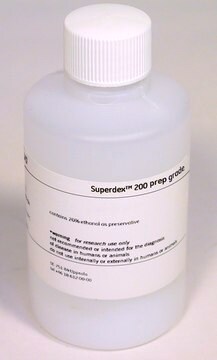GE28-9909-46
Superdex® 200 Increase 3.2/300
column L × I.D. 30 cm × 3.2 mm, 8.6 μm particle size
Sinonimo/i:
Superdex 200 Increase
About This Item
Prodotti consigliati
Materiali
glass column
titanium frit
Nome Commerciale
Superdex®
PM
10000-600000 Da (globular proteins)
Confezionamento
1 ea of
Parametri
<0.15 ml/min flow rate
3.0 Mpa (652 psi)
4-50 mL sample volume
Volume del letto
~2.4 mL
Lungh. × diam. int. colonna
30 cm × 3.2 mm
Matrice
agarose-dextran composite
polymeric
Dimensione particelle
8.6 μm
cleaning
1-14
working range
3-12
Tecnica di separazione
size exclusion (SEC)
Descrizione generale
Superdex™ 200 Increase is a next-generation, dextran-agarose composite matrix for SEC. With smaller and more rigid beads than their predecessors, Superdex™ Increase columns deliver higher resolution purification in shorter run times.
Superdex™ 200 Increase has a selectivity curve optimized for excellent resolution of antibodies and macromolecules within the range Mr ~ 100 000 to ~ 300 000. It is well suited for detection and separation of antibody monomers, dimers, and aggregates present in monoclonal antibody preparations. The outstanding resolving power of this resin facilitates protein characterization, including analysis of antibody size variants, assessment of membrane protein size homogeneity, and the study of protein-protein interactions.
Superdex™ 200 Increase is optimized to give high resolution separation for proteins with molecular weights in the range Mr ~ 100 000 to ~ 300 000. Superose™ 6 Increase provides a complementary fractionation range, resolving very large protein complexes and macromolecules that Superdex 200 Increase cannot separate.
This agarose-based resin is alkali-resistant and supports cleaning-in-place (CIP) procedures. This capability allows the same column to be used for different proteins, with minimal risk of carry-over between samples.
Caratteristiche e vantaggi
- Enhanced performance: improved resolution and runtime compared to predecessor Superdex™ 200.
- Very high resolution: small bead size and narrow particle size distribution provide high resolution, for high protein purity.
- High flow rates: rigid beads give excellent pressure/flow properties.
Compatibilità
Stoccaggio e stabilità
Note legali
Avvertenze
Warning
Indicazioni di pericolo
Consigli di prudenza
Codice della classe di stoccaggio
3 - Flammable liquids
Certificati d'analisi (COA)
Cerca il Certificati d'analisi (COA) digitando il numero di lotto/batch corrispondente. I numeri di lotto o di batch sono stampati sull'etichetta dei prodotti dopo la parola ‘Lotto’ o ‘Batch’.
Possiedi già questo prodotto?
I documenti relativi ai prodotti acquistati recentemente sono disponibili nell’Archivio dei documenti.
I clienti hanno visto anche
Articoli
Pressure is generated by the flow through the chromatographic system. For optimal chromatography functionality, it is important to understand the principle of the pressure drop over the different parts of a system.
This page shows how to perform a purification of His-tagged membrane proteins.
Protocolli
Samples for chromatographic purification should be clear and free from particulate matter. Simple steps to clarify a sample before beginning purification will avoid clogging the column, can reduce the need for stringent washing procedures, and can extend the life of the chromatographic medium.
Il team dei nostri ricercatori vanta grande esperienza in tutte le aree della ricerca quali Life Science, scienza dei materiali, sintesi chimica, cromatografia, discipline analitiche, ecc..
Contatta l'Assistenza Tecnica.







